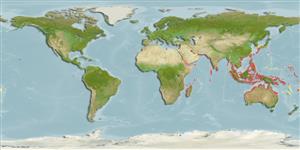Common names from other countries
Issue
Mugil amarulus Valenciennes, 1936, Mugil kelaartii Günther, 1861, and Mugil longimanus Günther, 1861 are synonyms of Moolgarda perusii (Valenciennes, 1836) according to Eschmeyer (CofF ver Jan. 2013: Ref. 92887).
Environment: milieu / climate zone / depth range / distribution range
Ecología
marino; agua dulce; salobre demersal; catadromo (Ref. 26213); rango de profundidad 0 - 3 m (Ref. 86942). Tropical
Indo-West Pacific (Ref. 4393), including African east coast river estuaries as far south as Algoa Bay, South Africa (Ref. 52193). Recorded as far inland as Zimbabwe on the Save River (Ref. 52193).
Length at first maturity / Tamaño / Peso / Age
Maturity: Lm 15.1 range ? - ? cm
Max length : 41.0 cm SL macho / no sexado; (Ref. 52193); common length : 25.0 cm TL macho / no sexado; (Ref. 30573)
Espinas dorsales (total) : 4 - 5; Radios blandos dorsales (total) : 9 - 10; Espinas anales: 2 - 3; Radios blandos anales: 9.
Occur in shallow coastal waters, including estuaries and backwaters, frequently enters freshwater. Form larger aggregations during spawning which takes place at sea. Young individuals enter tidal rivers. Feed on organic matter contained in sand and mud (Ref. 30573). Oviparous, eggs are pelagic and non-adhesive (Ref. 205). Marketed fresh and salted. Decays rapidly, but well liked when fresh.
Life cycle and mating behavior
Maturities | Reproducción | Spawnings | Egg(s) | Fecundities | Larva
Thomson, J.M., 1984. Mugilidae. In W. Fischer and G. Bianchi (eds.) FAO species identification sheets for fishery purposes. Western Indian Ocean (Fishing Area 51). volume 3. [pag. var.]. FAO, Rome. (Ref. 2830)
IUCN Red List Status (Ref. 130435)
CITES (Ref. 128078)
Not Evaluated
Threat to humans
Harmless
Human uses
Pesquerías: comercial; carnada: usually
Herramientas
Special reports
Download XML
Fuentes de Internet
Estimates based on models
Preferred temperature (Ref.
115969): 24.8 - 29.3, mean 28.5 (based on 2356 cells).
Phylogenetic diversity index (Ref.
82804): PD
50 = 0.5625 [Uniqueness, from 0.5 = low to 2.0 = high].
Bayesian length-weight: a=0.01148 (0.00996 - 0.01324), b=2.94 (2.90 - 2.98), in cm Total Length, based on LWR estimates for this species (Ref.
93245).
Nivel trófico (Ref.
69278): 2.4 ±0.21 se; based on food items.
Resiliencia (Ref.
120179): Medio, población duplicada en un tiempo mínimo de 1.4-4.4 años (K=0.3).
Fishing Vulnerability (Ref.
59153): Low to moderate vulnerability (34 of 100).
